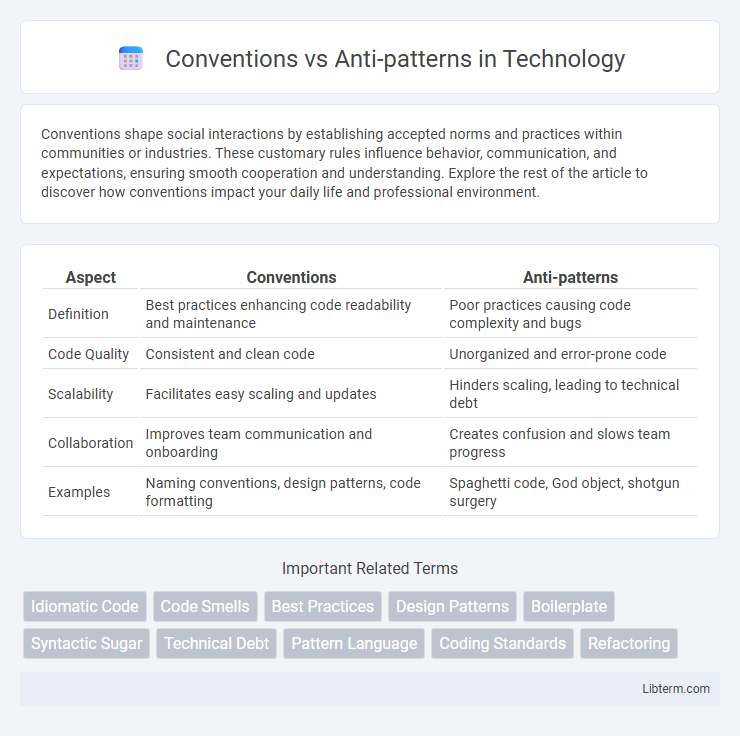Conventions shape social interactions by establishing accepted norms and practices within communities or industries. These customary rules influence behavior, communication, and expectations, ensuring smooth cooperation and understanding. Explore the rest of the article to discover how conventions impact your daily life and professional environment.
Table of Comparison
| Aspect | Conventions | Anti-patterns |
|---|---|---|
| Definition | Best practices enhancing code readability and maintenance | Poor practices causing code complexity and bugs |
| Code Quality | Consistent and clean code | Unorganized and error-prone code |
| Scalability | Facilitates easy scaling and updates | Hinders scaling, leading to technical debt |
| Collaboration | Improves team communication and onboarding | Creates confusion and slows team progress |
| Examples | Naming conventions, design patterns, code formatting | Spaghetti code, God object, shotgun surgery |
Understanding Coding Conventions
Understanding coding conventions enhances code readability, maintainability, and collaboration by providing consistent naming, formatting, and structural guidelines within a development team. These established standards prevent common anti-patterns such as inconsistent indentation, ambiguous variable names, and poor code organization that lead to bugs and technical debt. Adhering to coding conventions supports efficient code reviews and debugging, ensuring scalable and high-quality software development.
What Are Anti-patterns?
Anti-patterns are common responses to recurring problems that initially appear beneficial but ultimately lead to negative consequences and decreased efficiency. They often arise from poor design choices, lack of experience, or misapplication of best practices, resulting in technical debt and maintenance challenges. Recognizing anti-patterns enables developers to avoid costly mistakes and implement more effective, sustainable solutions.
Benefits of Following Conventions
Following conventions in software development ensures consistent code structure, improving readability and maintainability across teams. It reduces errors by providing standardized patterns that guide developers, enabling faster onboarding and collaboration. Adhering to established conventions also enhances code quality, facilitates automated testing, and promotes scalability in complex projects.
Risks Associated with Anti-patterns
Anti-patterns in software development introduce significant risks such as increased technical debt, reduced code maintainability, and higher defect rates, ultimately leading to project delays and cost overruns. Unlike well-established conventions that foster code consistency and predictability, anti-patterns promote inefficient workflows and obscure design flaws that complicate debugging and future enhancements. Identifying and refactoring anti-patterns early mitigates these risks, ensuring robust architecture and improved system reliability.
Common Coding Conventions in Development
Common coding conventions in development include consistent indentation, meaningful variable naming, and proper code commenting to enhance readability and maintainability. Following established style guides, such as PEP 8 for Python or Google's Java Style Guide, ensures uniformity across team projects and reduces bugs. Ignoring these conventions often leads to anti-patterns like spaghetti code, which complicates debugging and slows development progress.
Typical Software Anti-patterns to Avoid
Typical software anti-patterns to avoid include "God Object," where a single class handles excessive responsibilities, leading to maintenance difficulties and tight coupling. Another common anti-pattern is "Spaghetti Code," characterized by unstructured and tangled control flow that hampers readability and debugging. Avoiding "Golden Hammer," the misuse of a familiar tool or concept for all problems, is crucial to ensure appropriate solutions and maintain software quality.
How Conventions Improve Code Quality
Conventions improve code quality by establishing consistent coding standards that enhance readability and maintainability across development teams. Adhering to conventions reduces the likelihood of errors and facilitates smoother code reviews, enabling faster identification and resolution of issues. This uniformity also simplifies onboarding new developers by providing clear expectations, leading to more efficient collaboration and higher overall software reliability.
Detecting and Refactoring Anti-patterns
Detecting anti-patterns involves identifying common signs such as duplicated code, excessive coupling, and large classes that hinder maintainability and scalability. Refactoring anti-patterns requires techniques like extracting methods, reducing dependencies, and simplifying complex logic to improve code readability and performance. Effective use of static analysis tools and code reviews enhances early detection and facilitates systematic refactoring of anti-patterns.
Conventions vs Anti-patterns: Key Differences
Conventions are established best practices and industry standards that promote code readability, maintainability, and collaboration, while anti-patterns represent common but ineffective or harmful design choices that lead to technical debt and reduced software quality. Key differences include that conventions drive consistency and predictable behavior across codebases, whereas anti-patterns introduce complexity, bugs, and hinder scalability. Adhering to conventions ensures efficient development workflows, whereas recognizing and avoiding anti-patterns prevents problematic and costly refactoring efforts.
Best Practices for Enforcing Coding Standards
Conventions establish consistent coding standards that enhance readability, maintainability, and collaboration across development teams, serving as a foundation for best practices in software engineering. Anti-patterns, such as inconsistent naming or overcomplicated code structures, undermine code quality and increase technical debt, making enforcement of standards critical. Implementing automated tools like linters and code reviews ensures adherence to conventions, reduces errors, and promotes a sustainable development lifecycle.
Conventions Infographic

 libterm.com
libterm.com